Principles of Mental Health Nursing Assignment 1: Psychotropic Drugs
VerifiedAdded on 2022/09/07
|13
|3437
|16
Essay
AI Summary
This essay critically examines the controversy surrounding the use of psychotropic medications in treating mental illnesses. It delves into the benefits versus the harms, highlighting potential side effects such as addiction, cognitive decline, and adverse reactions in specific populations like the elderly, children, and pregnant women. The essay explores the challenges faced by registered nurses who administer these medications, including knowledge gaps, lack of authority, and ethical dilemmas. It discusses the importance of continuous professional development, proper collaboration with doctors and families, and adherence to legal and ethical guidelines. The essay also references initiatives by the Australian government to minimize the harmful impacts of these drugs. The discussion covers the importance of appropriate dosage, patient monitoring, and the consideration of alternative therapies such as psychotherapy and family therapy, especially in cases of children and adolescents. Finally, the assignment highlights the need for nurses to be aware of legal and ethical issues related to medication administration and the importance of staying updated with current standards of care.
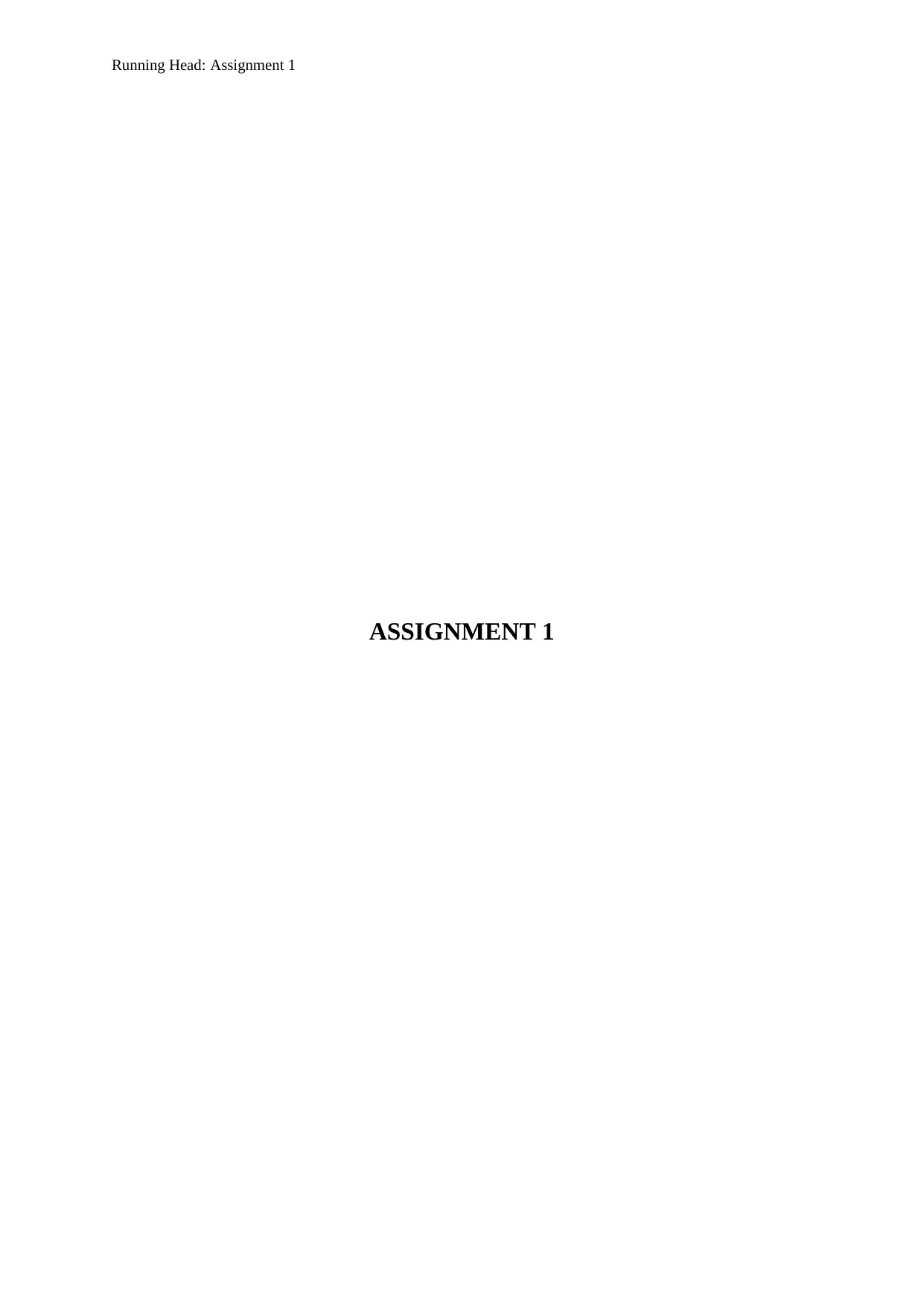
Running Head: Assignment 1
ASSIGNMENT 1
ASSIGNMENT 1
Paraphrase This Document
Need a fresh take? Get an instant paraphrase of this document with our AI Paraphraser
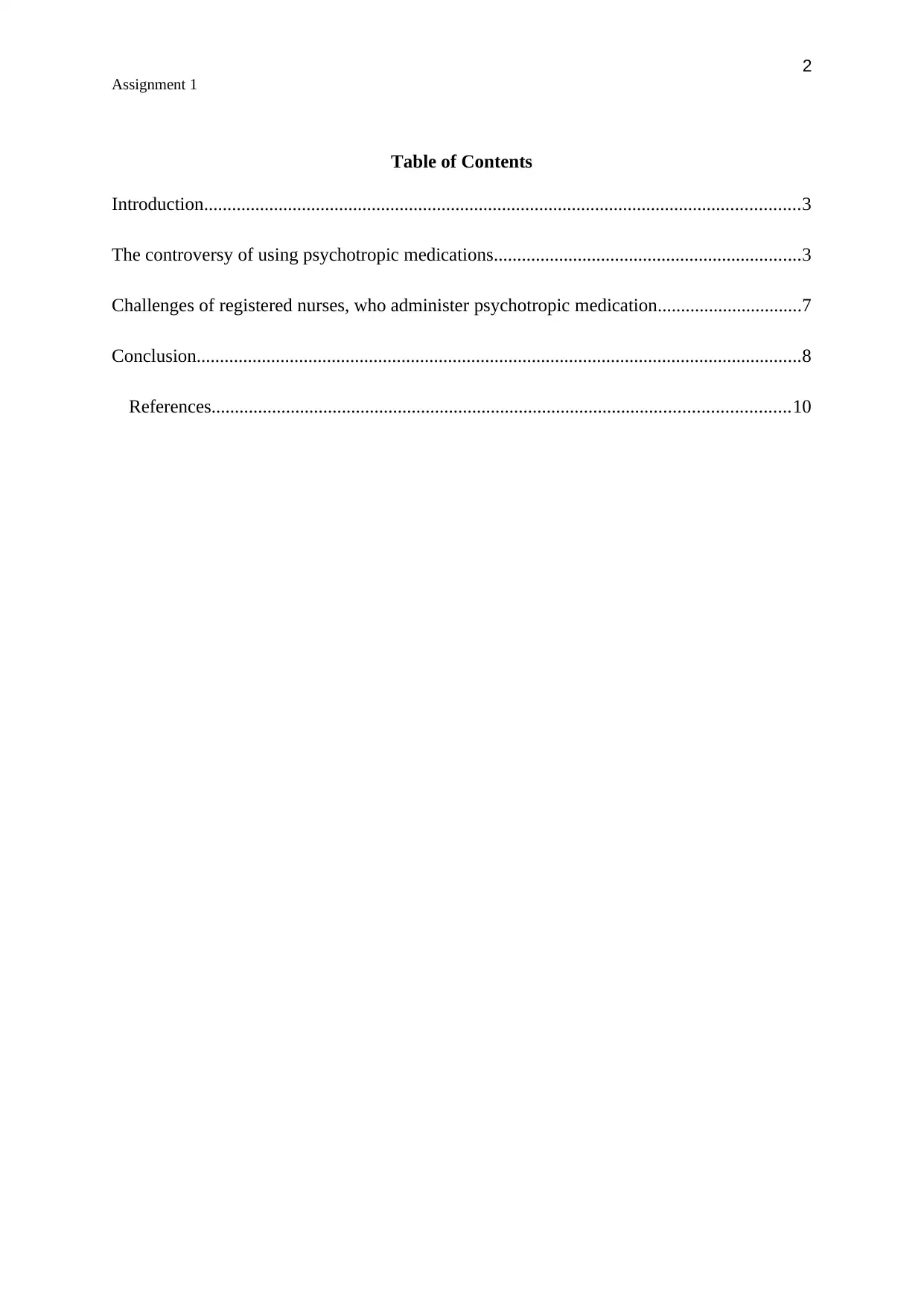
2
Assignment 1
Table of Contents
Introduction................................................................................................................................3
The controversy of using psychotropic medications..................................................................3
Challenges of registered nurses, who administer psychotropic medication...............................7
Conclusion..................................................................................................................................8
References............................................................................................................................10
Assignment 1
Table of Contents
Introduction................................................................................................................................3
The controversy of using psychotropic medications..................................................................3
Challenges of registered nurses, who administer psychotropic medication...............................7
Conclusion..................................................................................................................................8
References............................................................................................................................10
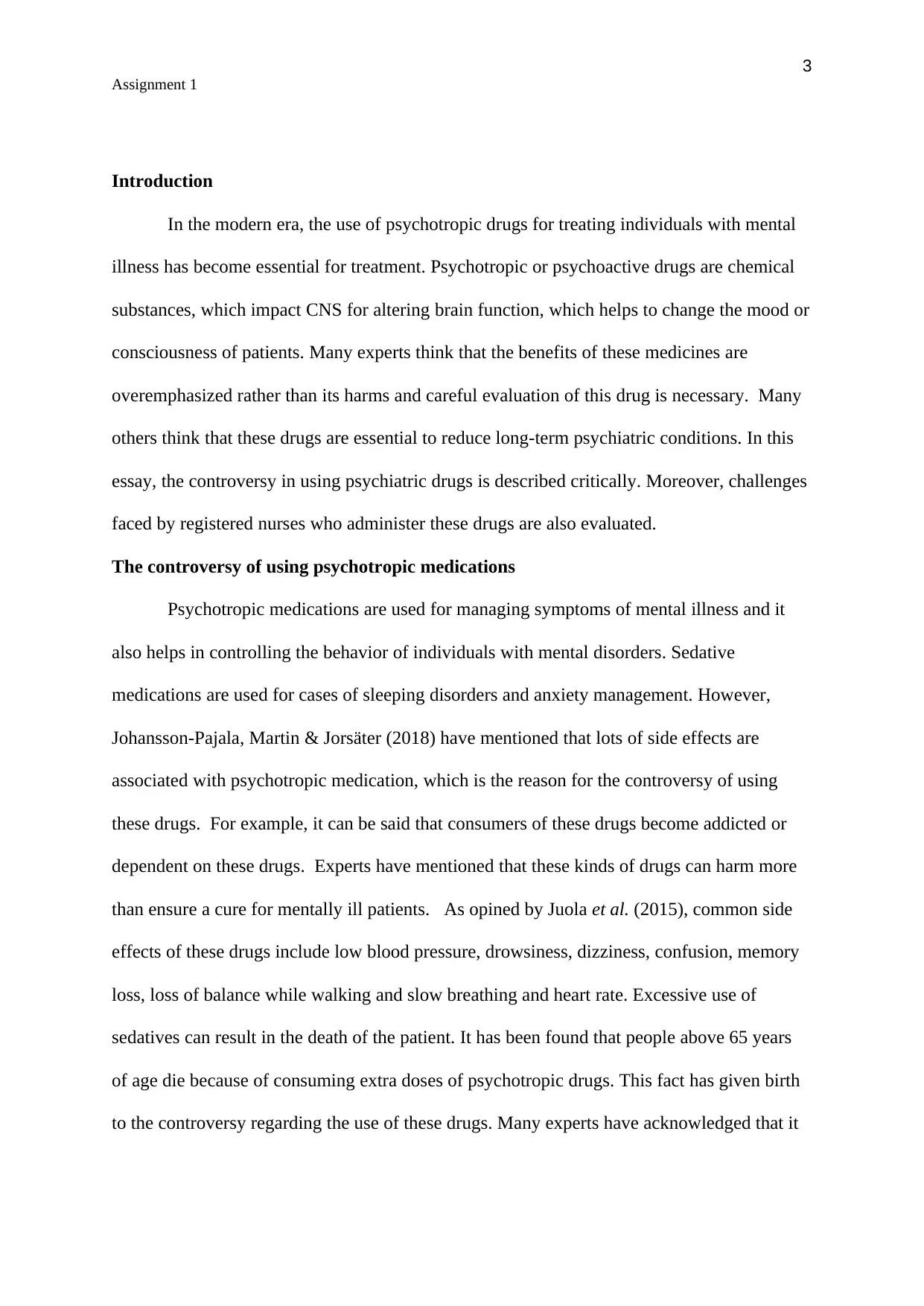
3
Assignment 1
Introduction
In the modern era, the use of psychotropic drugs for treating individuals with mental
illness has become essential for treatment. Psychotropic or psychoactive drugs are chemical
substances, which impact CNS for altering brain function, which helps to change the mood or
consciousness of patients. Many experts think that the benefits of these medicines are
overemphasized rather than its harms and careful evaluation of this drug is necessary. Many
others think that these drugs are essential to reduce long-term psychiatric conditions. In this
essay, the controversy in using psychiatric drugs is described critically. Moreover, challenges
faced by registered nurses who administer these drugs are also evaluated.
The controversy of using psychotropic medications
Psychotropic medications are used for managing symptoms of mental illness and it
also helps in controlling the behavior of individuals with mental disorders. Sedative
medications are used for cases of sleeping disorders and anxiety management. However,
Johansson-Pajala, Martin & Jorsäter (2018) have mentioned that lots of side effects are
associated with psychotropic medication, which is the reason for the controversy of using
these drugs. For example, it can be said that consumers of these drugs become addicted or
dependent on these drugs. Experts have mentioned that these kinds of drugs can harm more
than ensure a cure for mentally ill patients. As opined by Juola et al. (2015), common side
effects of these drugs include low blood pressure, drowsiness, dizziness, confusion, memory
loss, loss of balance while walking and slow breathing and heart rate. Excessive use of
sedatives can result in the death of the patient. It has been found that people above 65 years
of age die because of consuming extra doses of psychotropic drugs. This fact has given birth
to the controversy regarding the use of these drugs. Many experts have acknowledged that it
Assignment 1
Introduction
In the modern era, the use of psychotropic drugs for treating individuals with mental
illness has become essential for treatment. Psychotropic or psychoactive drugs are chemical
substances, which impact CNS for altering brain function, which helps to change the mood or
consciousness of patients. Many experts think that the benefits of these medicines are
overemphasized rather than its harms and careful evaluation of this drug is necessary. Many
others think that these drugs are essential to reduce long-term psychiatric conditions. In this
essay, the controversy in using psychiatric drugs is described critically. Moreover, challenges
faced by registered nurses who administer these drugs are also evaluated.
The controversy of using psychotropic medications
Psychotropic medications are used for managing symptoms of mental illness and it
also helps in controlling the behavior of individuals with mental disorders. Sedative
medications are used for cases of sleeping disorders and anxiety management. However,
Johansson-Pajala, Martin & Jorsäter (2018) have mentioned that lots of side effects are
associated with psychotropic medication, which is the reason for the controversy of using
these drugs. For example, it can be said that consumers of these drugs become addicted or
dependent on these drugs. Experts have mentioned that these kinds of drugs can harm more
than ensure a cure for mentally ill patients. As opined by Juola et al. (2015), common side
effects of these drugs include low blood pressure, drowsiness, dizziness, confusion, memory
loss, loss of balance while walking and slow breathing and heart rate. Excessive use of
sedatives can result in the death of the patient. It has been found that people above 65 years
of age die because of consuming extra doses of psychotropic drugs. This fact has given birth
to the controversy regarding the use of these drugs. Many experts have acknowledged that it
⊘ This is a preview!⊘
Do you want full access?
Subscribe today to unlock all pages.

Trusted by 1+ million students worldwide
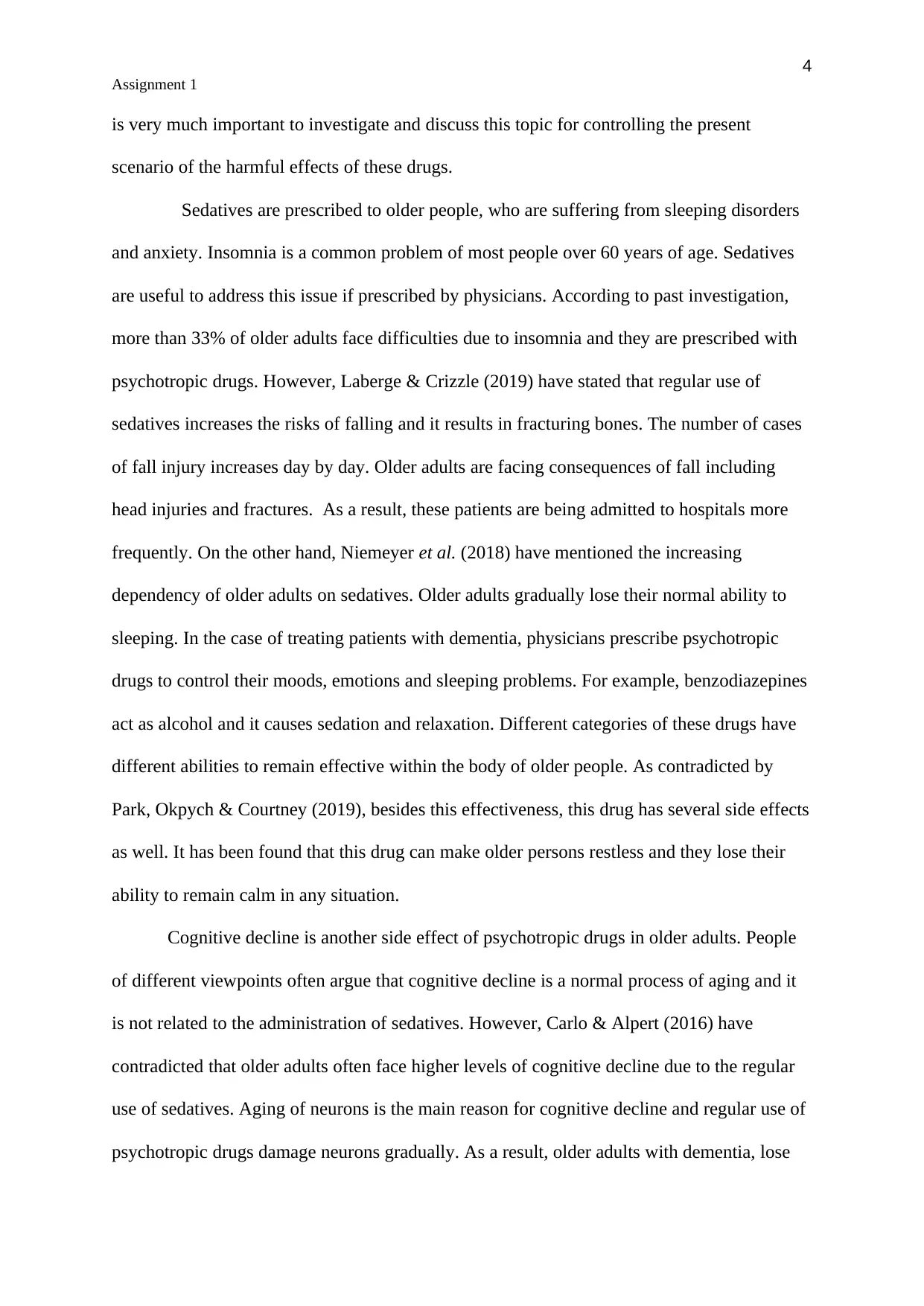
4
Assignment 1
is very much important to investigate and discuss this topic for controlling the present
scenario of the harmful effects of these drugs.
Sedatives are prescribed to older people, who are suffering from sleeping disorders
and anxiety. Insomnia is a common problem of most people over 60 years of age. Sedatives
are useful to address this issue if prescribed by physicians. According to past investigation,
more than 33% of older adults face difficulties due to insomnia and they are prescribed with
psychotropic drugs. However, Laberge & Crizzle (2019) have stated that regular use of
sedatives increases the risks of falling and it results in fracturing bones. The number of cases
of fall injury increases day by day. Older adults are facing consequences of fall including
head injuries and fractures. As a result, these patients are being admitted to hospitals more
frequently. On the other hand, Niemeyer et al. (2018) have mentioned the increasing
dependency of older adults on sedatives. Older adults gradually lose their normal ability to
sleeping. In the case of treating patients with dementia, physicians prescribe psychotropic
drugs to control their moods, emotions and sleeping problems. For example, benzodiazepines
act as alcohol and it causes sedation and relaxation. Different categories of these drugs have
different abilities to remain effective within the body of older people. As contradicted by
Park, Okpych & Courtney (2019), besides this effectiveness, this drug has several side effects
as well. It has been found that this drug can make older persons restless and they lose their
ability to remain calm in any situation.
Cognitive decline is another side effect of psychotropic drugs in older adults. People
of different viewpoints often argue that cognitive decline is a normal process of aging and it
is not related to the administration of sedatives. However, Carlo & Alpert (2016) have
contradicted that older adults often face higher levels of cognitive decline due to the regular
use of sedatives. Aging of neurons is the main reason for cognitive decline and regular use of
psychotropic drugs damage neurons gradually. As a result, older adults with dementia, lose
Assignment 1
is very much important to investigate and discuss this topic for controlling the present
scenario of the harmful effects of these drugs.
Sedatives are prescribed to older people, who are suffering from sleeping disorders
and anxiety. Insomnia is a common problem of most people over 60 years of age. Sedatives
are useful to address this issue if prescribed by physicians. According to past investigation,
more than 33% of older adults face difficulties due to insomnia and they are prescribed with
psychotropic drugs. However, Laberge & Crizzle (2019) have stated that regular use of
sedatives increases the risks of falling and it results in fracturing bones. The number of cases
of fall injury increases day by day. Older adults are facing consequences of fall including
head injuries and fractures. As a result, these patients are being admitted to hospitals more
frequently. On the other hand, Niemeyer et al. (2018) have mentioned the increasing
dependency of older adults on sedatives. Older adults gradually lose their normal ability to
sleeping. In the case of treating patients with dementia, physicians prescribe psychotropic
drugs to control their moods, emotions and sleeping problems. For example, benzodiazepines
act as alcohol and it causes sedation and relaxation. Different categories of these drugs have
different abilities to remain effective within the body of older people. As contradicted by
Park, Okpych & Courtney (2019), besides this effectiveness, this drug has several side effects
as well. It has been found that this drug can make older persons restless and they lose their
ability to remain calm in any situation.
Cognitive decline is another side effect of psychotropic drugs in older adults. People
of different viewpoints often argue that cognitive decline is a normal process of aging and it
is not related to the administration of sedatives. However, Carlo & Alpert (2016) have
contradicted that older adults often face higher levels of cognitive decline due to the regular
use of sedatives. Aging of neurons is the main reason for cognitive decline and regular use of
psychotropic drugs damage neurons gradually. As a result, older adults with dementia, lose
Paraphrase This Document
Need a fresh take? Get an instant paraphrase of this document with our AI Paraphraser
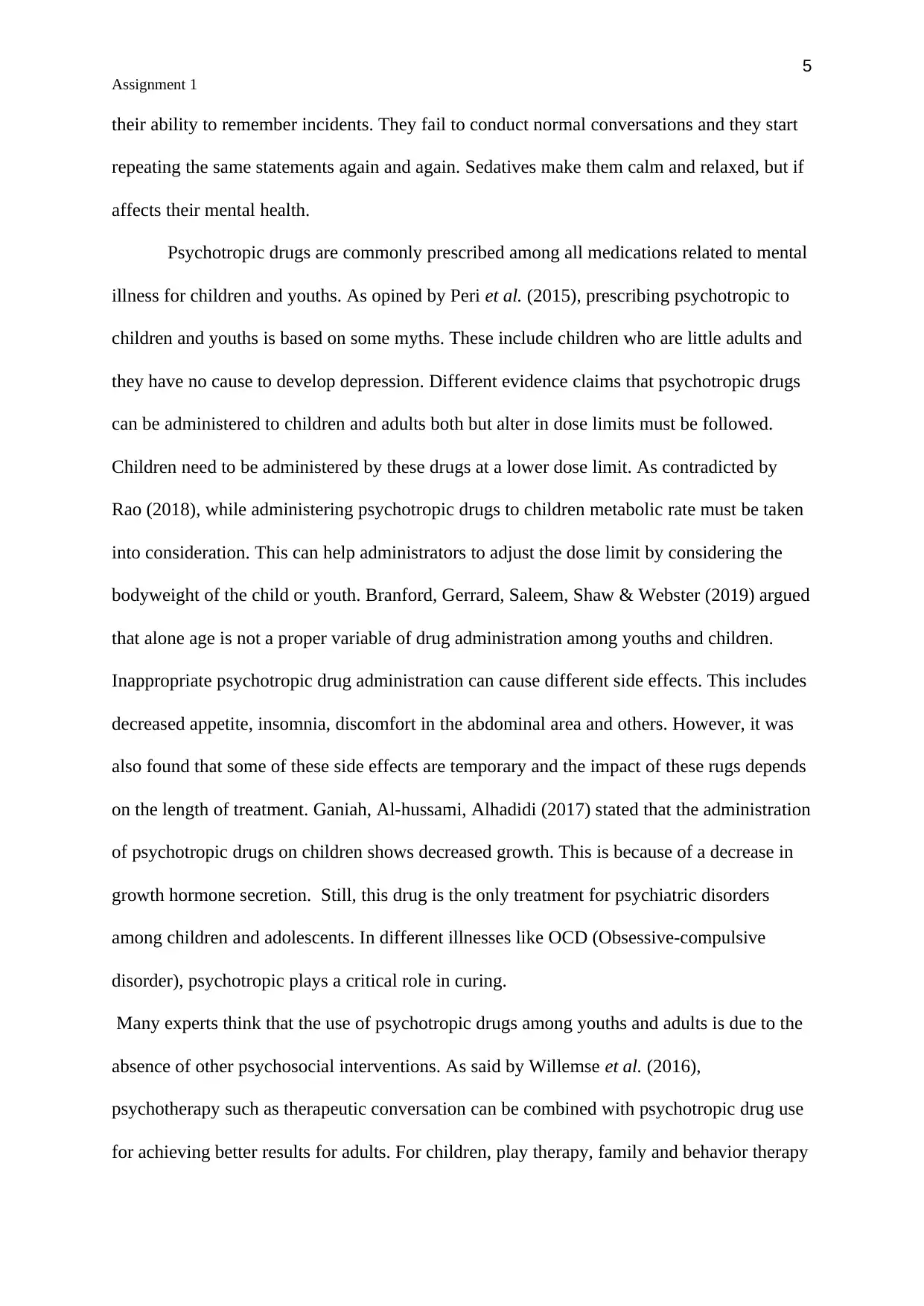
5
Assignment 1
their ability to remember incidents. They fail to conduct normal conversations and they start
repeating the same statements again and again. Sedatives make them calm and relaxed, but if
affects their mental health.
Psychotropic drugs are commonly prescribed among all medications related to mental
illness for children and youths. As opined by Peri et al. (2015), prescribing psychotropic to
children and youths is based on some myths. These include children who are little adults and
they have no cause to develop depression. Different evidence claims that psychotropic drugs
can be administered to children and adults both but alter in dose limits must be followed.
Children need to be administered by these drugs at a lower dose limit. As contradicted by
Rao (2018), while administering psychotropic drugs to children metabolic rate must be taken
into consideration. This can help administrators to adjust the dose limit by considering the
bodyweight of the child or youth. Branford, Gerrard, Saleem, Shaw & Webster (2019) argued
that alone age is not a proper variable of drug administration among youths and children.
Inappropriate psychotropic drug administration can cause different side effects. This includes
decreased appetite, insomnia, discomfort in the abdominal area and others. However, it was
also found that some of these side effects are temporary and the impact of these rugs depends
on the length of treatment. Ganiah, Al-hussami, Alhadidi (2017) stated that the administration
of psychotropic drugs on children shows decreased growth. This is because of a decrease in
growth hormone secretion. Still, this drug is the only treatment for psychiatric disorders
among children and adolescents. In different illnesses like OCD (Obsessive-compulsive
disorder), psychotropic plays a critical role in curing.
Many experts think that the use of psychotropic drugs among youths and adults is due to the
absence of other psychosocial interventions. As said by Willemse et al. (2016),
psychotherapy such as therapeutic conversation can be combined with psychotropic drug use
for achieving better results for adults. For children, play therapy, family and behavior therapy
Assignment 1
their ability to remember incidents. They fail to conduct normal conversations and they start
repeating the same statements again and again. Sedatives make them calm and relaxed, but if
affects their mental health.
Psychotropic drugs are commonly prescribed among all medications related to mental
illness for children and youths. As opined by Peri et al. (2015), prescribing psychotropic to
children and youths is based on some myths. These include children who are little adults and
they have no cause to develop depression. Different evidence claims that psychotropic drugs
can be administered to children and adults both but alter in dose limits must be followed.
Children need to be administered by these drugs at a lower dose limit. As contradicted by
Rao (2018), while administering psychotropic drugs to children metabolic rate must be taken
into consideration. This can help administrators to adjust the dose limit by considering the
bodyweight of the child or youth. Branford, Gerrard, Saleem, Shaw & Webster (2019) argued
that alone age is not a proper variable of drug administration among youths and children.
Inappropriate psychotropic drug administration can cause different side effects. This includes
decreased appetite, insomnia, discomfort in the abdominal area and others. However, it was
also found that some of these side effects are temporary and the impact of these rugs depends
on the length of treatment. Ganiah, Al-hussami, Alhadidi (2017) stated that the administration
of psychotropic drugs on children shows decreased growth. This is because of a decrease in
growth hormone secretion. Still, this drug is the only treatment for psychiatric disorders
among children and adolescents. In different illnesses like OCD (Obsessive-compulsive
disorder), psychotropic plays a critical role in curing.
Many experts think that the use of psychotropic drugs among youths and adults is due to the
absence of other psychosocial interventions. As said by Willemse et al. (2016),
psychotherapy such as therapeutic conversation can be combined with psychotropic drug use
for achieving better results for adults. For children, play therapy, family and behavior therapy
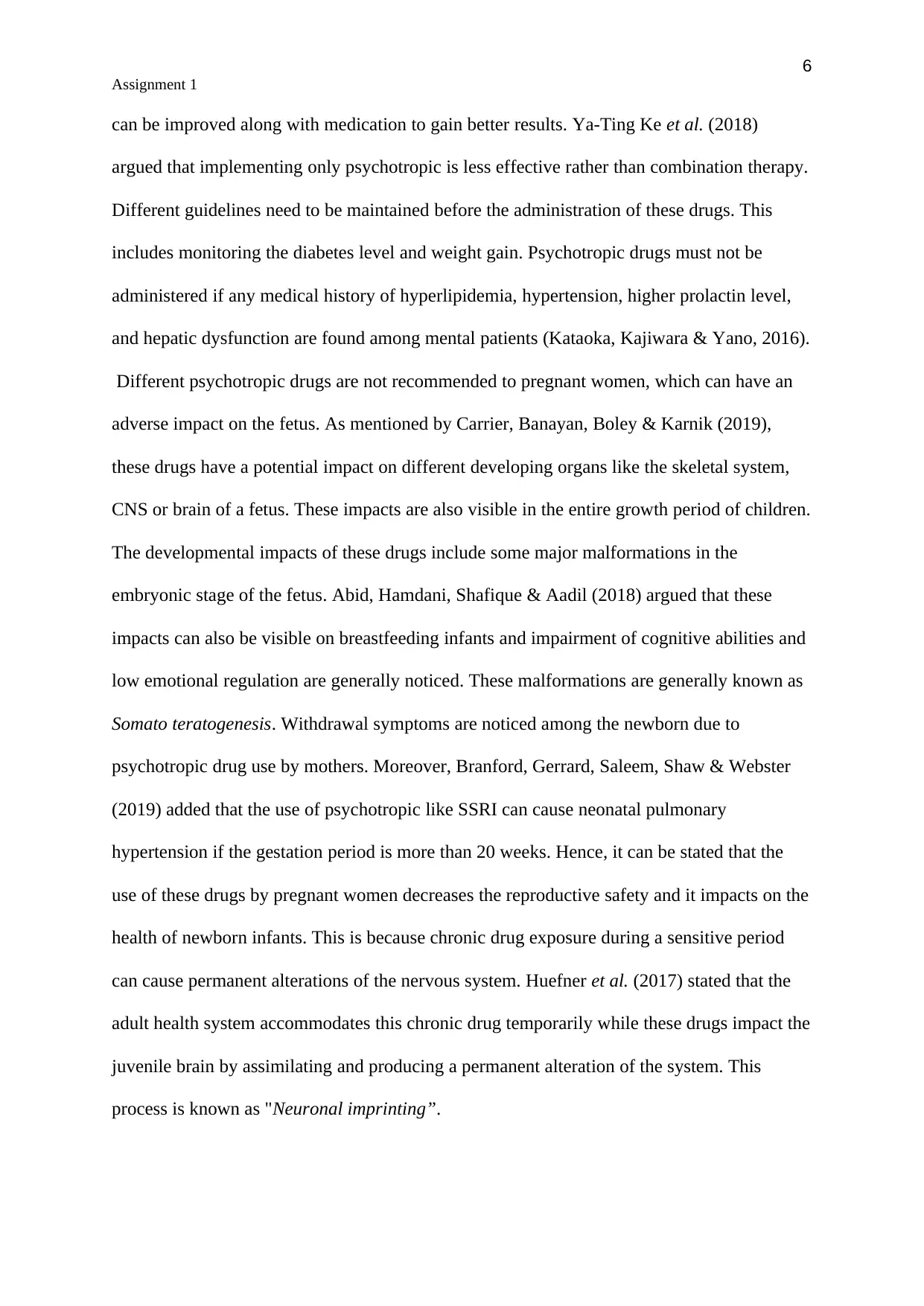
6
Assignment 1
can be improved along with medication to gain better results. Ya-Ting Ke et al. (2018)
argued that implementing only psychotropic is less effective rather than combination therapy.
Different guidelines need to be maintained before the administration of these drugs. This
includes monitoring the diabetes level and weight gain. Psychotropic drugs must not be
administered if any medical history of hyperlipidemia, hypertension, higher prolactin level,
and hepatic dysfunction are found among mental patients (Kataoka, Kajiwara & Yano, 2016).
Different psychotropic drugs are not recommended to pregnant women, which can have an
adverse impact on the fetus. As mentioned by Carrier, Banayan, Boley & Karnik (2019),
these drugs have a potential impact on different developing organs like the skeletal system,
CNS or brain of a fetus. These impacts are also visible in the entire growth period of children.
The developmental impacts of these drugs include some major malformations in the
embryonic stage of the fetus. Abid, Hamdani, Shafique & Aadil (2018) argued that these
impacts can also be visible on breastfeeding infants and impairment of cognitive abilities and
low emotional regulation are generally noticed. These malformations are generally known as
Somato teratogenesis. Withdrawal symptoms are noticed among the newborn due to
psychotropic drug use by mothers. Moreover, Branford, Gerrard, Saleem, Shaw & Webster
(2019) added that the use of psychotropic like SSRI can cause neonatal pulmonary
hypertension if the gestation period is more than 20 weeks. Hence, it can be stated that the
use of these drugs by pregnant women decreases the reproductive safety and it impacts on the
health of newborn infants. This is because chronic drug exposure during a sensitive period
can cause permanent alterations of the nervous system. Huefner et al. (2017) stated that the
adult health system accommodates this chronic drug temporarily while these drugs impact the
juvenile brain by assimilating and producing a permanent alteration of the system. This
process is known as "Neuronal imprinting”.
Assignment 1
can be improved along with medication to gain better results. Ya-Ting Ke et al. (2018)
argued that implementing only psychotropic is less effective rather than combination therapy.
Different guidelines need to be maintained before the administration of these drugs. This
includes monitoring the diabetes level and weight gain. Psychotropic drugs must not be
administered if any medical history of hyperlipidemia, hypertension, higher prolactin level,
and hepatic dysfunction are found among mental patients (Kataoka, Kajiwara & Yano, 2016).
Different psychotropic drugs are not recommended to pregnant women, which can have an
adverse impact on the fetus. As mentioned by Carrier, Banayan, Boley & Karnik (2019),
these drugs have a potential impact on different developing organs like the skeletal system,
CNS or brain of a fetus. These impacts are also visible in the entire growth period of children.
The developmental impacts of these drugs include some major malformations in the
embryonic stage of the fetus. Abid, Hamdani, Shafique & Aadil (2018) argued that these
impacts can also be visible on breastfeeding infants and impairment of cognitive abilities and
low emotional regulation are generally noticed. These malformations are generally known as
Somato teratogenesis. Withdrawal symptoms are noticed among the newborn due to
psychotropic drug use by mothers. Moreover, Branford, Gerrard, Saleem, Shaw & Webster
(2019) added that the use of psychotropic like SSRI can cause neonatal pulmonary
hypertension if the gestation period is more than 20 weeks. Hence, it can be stated that the
use of these drugs by pregnant women decreases the reproductive safety and it impacts on the
health of newborn infants. This is because chronic drug exposure during a sensitive period
can cause permanent alterations of the nervous system. Huefner et al. (2017) stated that the
adult health system accommodates this chronic drug temporarily while these drugs impact the
juvenile brain by assimilating and producing a permanent alteration of the system. This
process is known as "Neuronal imprinting”.
⊘ This is a preview!⊘
Do you want full access?
Subscribe today to unlock all pages.

Trusted by 1+ million students worldwide
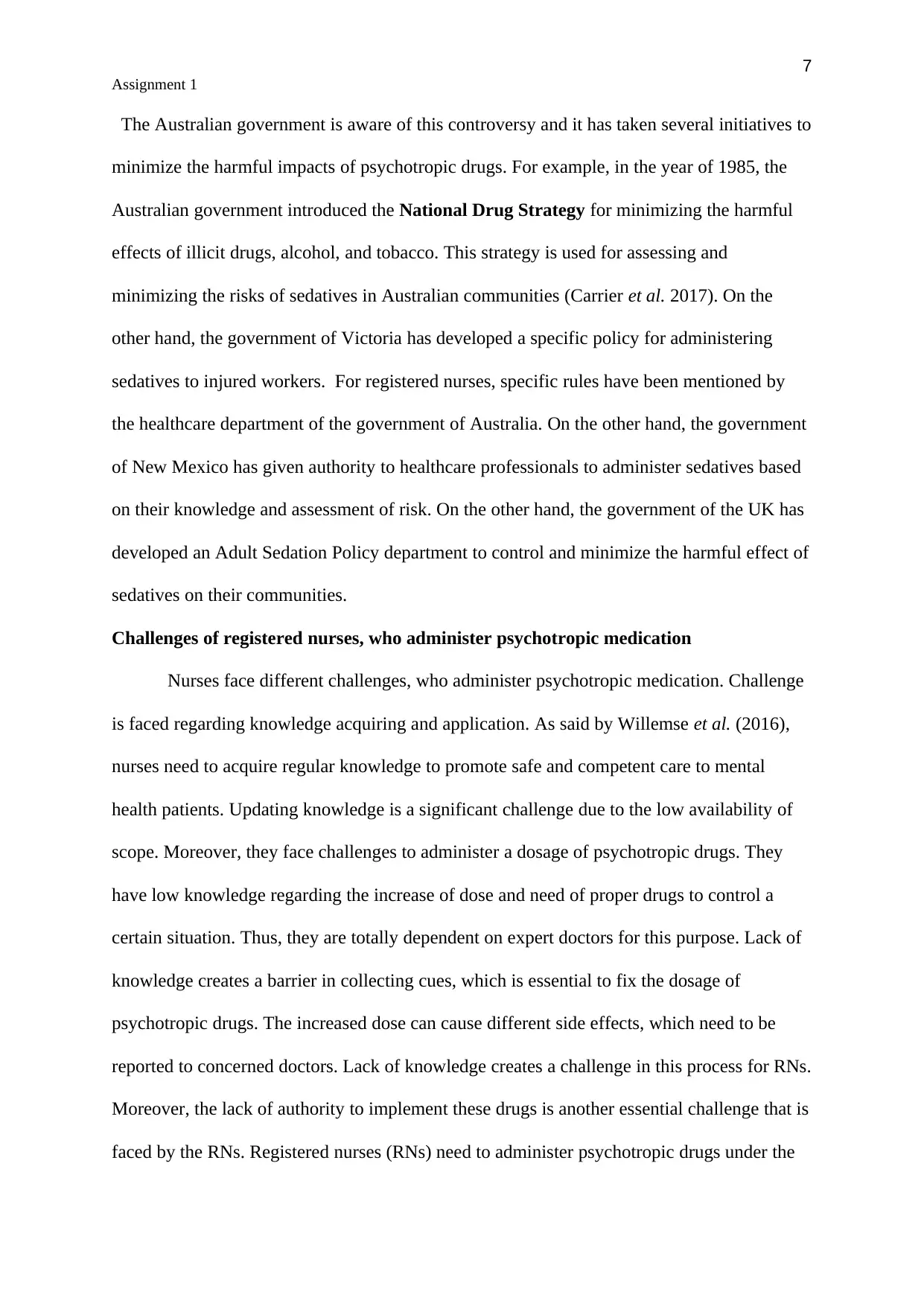
7
Assignment 1
The Australian government is aware of this controversy and it has taken several initiatives to
minimize the harmful impacts of psychotropic drugs. For example, in the year of 1985, the
Australian government introduced the National Drug Strategy for minimizing the harmful
effects of illicit drugs, alcohol, and tobacco. This strategy is used for assessing and
minimizing the risks of sedatives in Australian communities (Carrier et al. 2017). On the
other hand, the government of Victoria has developed a specific policy for administering
sedatives to injured workers. For registered nurses, specific rules have been mentioned by
the healthcare department of the government of Australia. On the other hand, the government
of New Mexico has given authority to healthcare professionals to administer sedatives based
on their knowledge and assessment of risk. On the other hand, the government of the UK has
developed an Adult Sedation Policy department to control and minimize the harmful effect of
sedatives on their communities.
Challenges of registered nurses, who administer psychotropic medication
Nurses face different challenges, who administer psychotropic medication. Challenge
is faced regarding knowledge acquiring and application. As said by Willemse et al. (2016),
nurses need to acquire regular knowledge to promote safe and competent care to mental
health patients. Updating knowledge is a significant challenge due to the low availability of
scope. Moreover, they face challenges to administer a dosage of psychotropic drugs. They
have low knowledge regarding the increase of dose and need of proper drugs to control a
certain situation. Thus, they are totally dependent on expert doctors for this purpose. Lack of
knowledge creates a barrier in collecting cues, which is essential to fix the dosage of
psychotropic drugs. The increased dose can cause different side effects, which need to be
reported to concerned doctors. Lack of knowledge creates a challenge in this process for RNs.
Moreover, the lack of authority to implement these drugs is another essential challenge that is
faced by the RNs. Registered nurses (RNs) need to administer psychotropic drugs under the
Assignment 1
The Australian government is aware of this controversy and it has taken several initiatives to
minimize the harmful impacts of psychotropic drugs. For example, in the year of 1985, the
Australian government introduced the National Drug Strategy for minimizing the harmful
effects of illicit drugs, alcohol, and tobacco. This strategy is used for assessing and
minimizing the risks of sedatives in Australian communities (Carrier et al. 2017). On the
other hand, the government of Victoria has developed a specific policy for administering
sedatives to injured workers. For registered nurses, specific rules have been mentioned by
the healthcare department of the government of Australia. On the other hand, the government
of New Mexico has given authority to healthcare professionals to administer sedatives based
on their knowledge and assessment of risk. On the other hand, the government of the UK has
developed an Adult Sedation Policy department to control and minimize the harmful effect of
sedatives on their communities.
Challenges of registered nurses, who administer psychotropic medication
Nurses face different challenges, who administer psychotropic medication. Challenge
is faced regarding knowledge acquiring and application. As said by Willemse et al. (2016),
nurses need to acquire regular knowledge to promote safe and competent care to mental
health patients. Updating knowledge is a significant challenge due to the low availability of
scope. Moreover, they face challenges to administer a dosage of psychotropic drugs. They
have low knowledge regarding the increase of dose and need of proper drugs to control a
certain situation. Thus, they are totally dependent on expert doctors for this purpose. Lack of
knowledge creates a barrier in collecting cues, which is essential to fix the dosage of
psychotropic drugs. The increased dose can cause different side effects, which need to be
reported to concerned doctors. Lack of knowledge creates a challenge in this process for RNs.
Moreover, the lack of authority to implement these drugs is another essential challenge that is
faced by the RNs. Registered nurses (RNs) need to administer psychotropic drugs under the
Paraphrase This Document
Need a fresh take? Get an instant paraphrase of this document with our AI Paraphraser
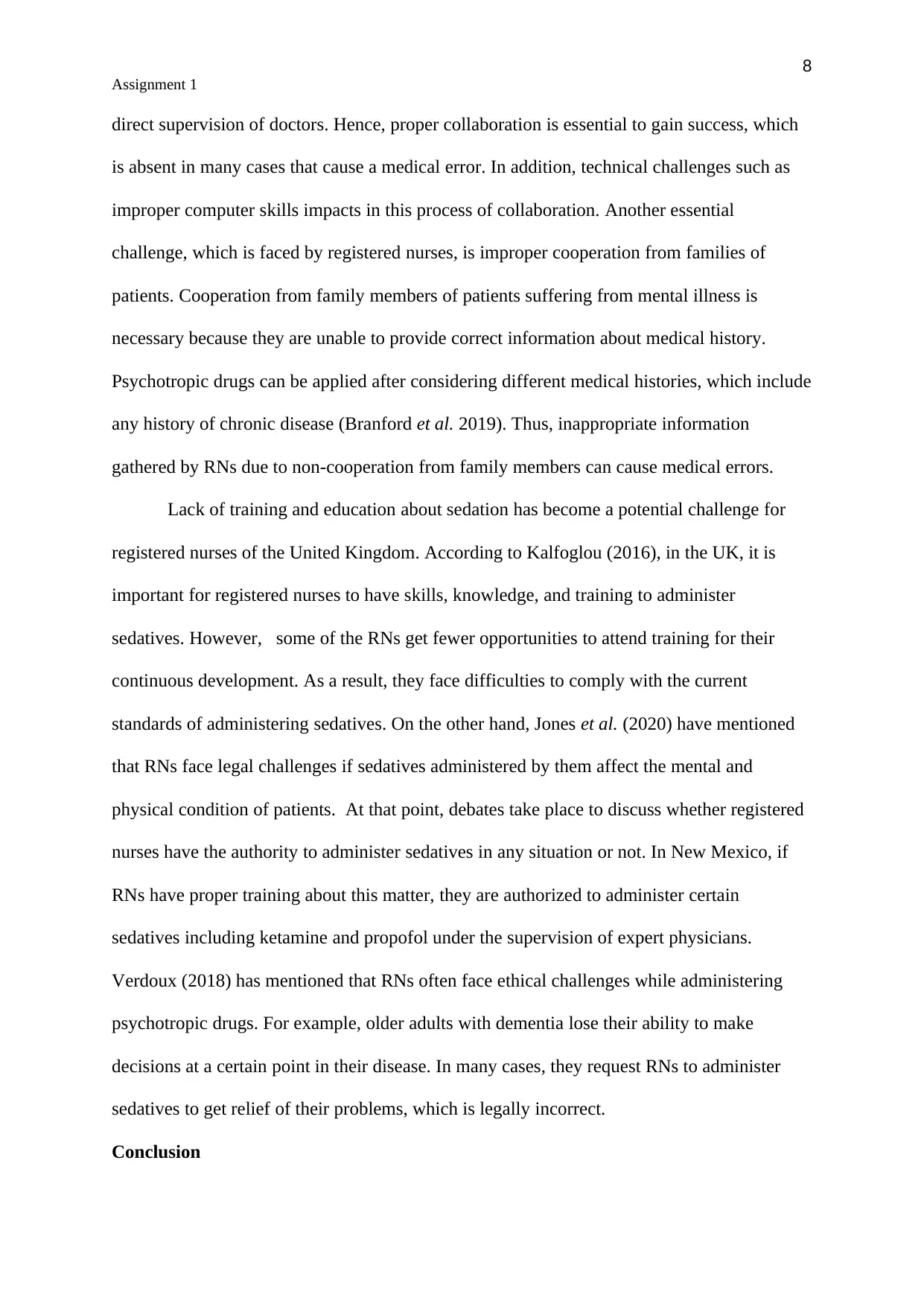
8
Assignment 1
direct supervision of doctors. Hence, proper collaboration is essential to gain success, which
is absent in many cases that cause a medical error. In addition, technical challenges such as
improper computer skills impacts in this process of collaboration. Another essential
challenge, which is faced by registered nurses, is improper cooperation from families of
patients. Cooperation from family members of patients suffering from mental illness is
necessary because they are unable to provide correct information about medical history.
Psychotropic drugs can be applied after considering different medical histories, which include
any history of chronic disease (Branford et al. 2019). Thus, inappropriate information
gathered by RNs due to non-cooperation from family members can cause medical errors.
Lack of training and education about sedation has become a potential challenge for
registered nurses of the United Kingdom. According to Kalfoglou (2016), in the UK, it is
important for registered nurses to have skills, knowledge, and training to administer
sedatives. However, some of the RNs get fewer opportunities to attend training for their
continuous development. As a result, they face difficulties to comply with the current
standards of administering sedatives. On the other hand, Jones et al. (2020) have mentioned
that RNs face legal challenges if sedatives administered by them affect the mental and
physical condition of patients. At that point, debates take place to discuss whether registered
nurses have the authority to administer sedatives in any situation or not. In New Mexico, if
RNs have proper training about this matter, they are authorized to administer certain
sedatives including ketamine and propofol under the supervision of expert physicians.
Verdoux (2018) has mentioned that RNs often face ethical challenges while administering
psychotropic drugs. For example, older adults with dementia lose their ability to make
decisions at a certain point in their disease. In many cases, they request RNs to administer
sedatives to get relief of their problems, which is legally incorrect.
Conclusion
Assignment 1
direct supervision of doctors. Hence, proper collaboration is essential to gain success, which
is absent in many cases that cause a medical error. In addition, technical challenges such as
improper computer skills impacts in this process of collaboration. Another essential
challenge, which is faced by registered nurses, is improper cooperation from families of
patients. Cooperation from family members of patients suffering from mental illness is
necessary because they are unable to provide correct information about medical history.
Psychotropic drugs can be applied after considering different medical histories, which include
any history of chronic disease (Branford et al. 2019). Thus, inappropriate information
gathered by RNs due to non-cooperation from family members can cause medical errors.
Lack of training and education about sedation has become a potential challenge for
registered nurses of the United Kingdom. According to Kalfoglou (2016), in the UK, it is
important for registered nurses to have skills, knowledge, and training to administer
sedatives. However, some of the RNs get fewer opportunities to attend training for their
continuous development. As a result, they face difficulties to comply with the current
standards of administering sedatives. On the other hand, Jones et al. (2020) have mentioned
that RNs face legal challenges if sedatives administered by them affect the mental and
physical condition of patients. At that point, debates take place to discuss whether registered
nurses have the authority to administer sedatives in any situation or not. In New Mexico, if
RNs have proper training about this matter, they are authorized to administer certain
sedatives including ketamine and propofol under the supervision of expert physicians.
Verdoux (2018) has mentioned that RNs often face ethical challenges while administering
psychotropic drugs. For example, older adults with dementia lose their ability to make
decisions at a certain point in their disease. In many cases, they request RNs to administer
sedatives to get relief of their problems, which is legally incorrect.
Conclusion
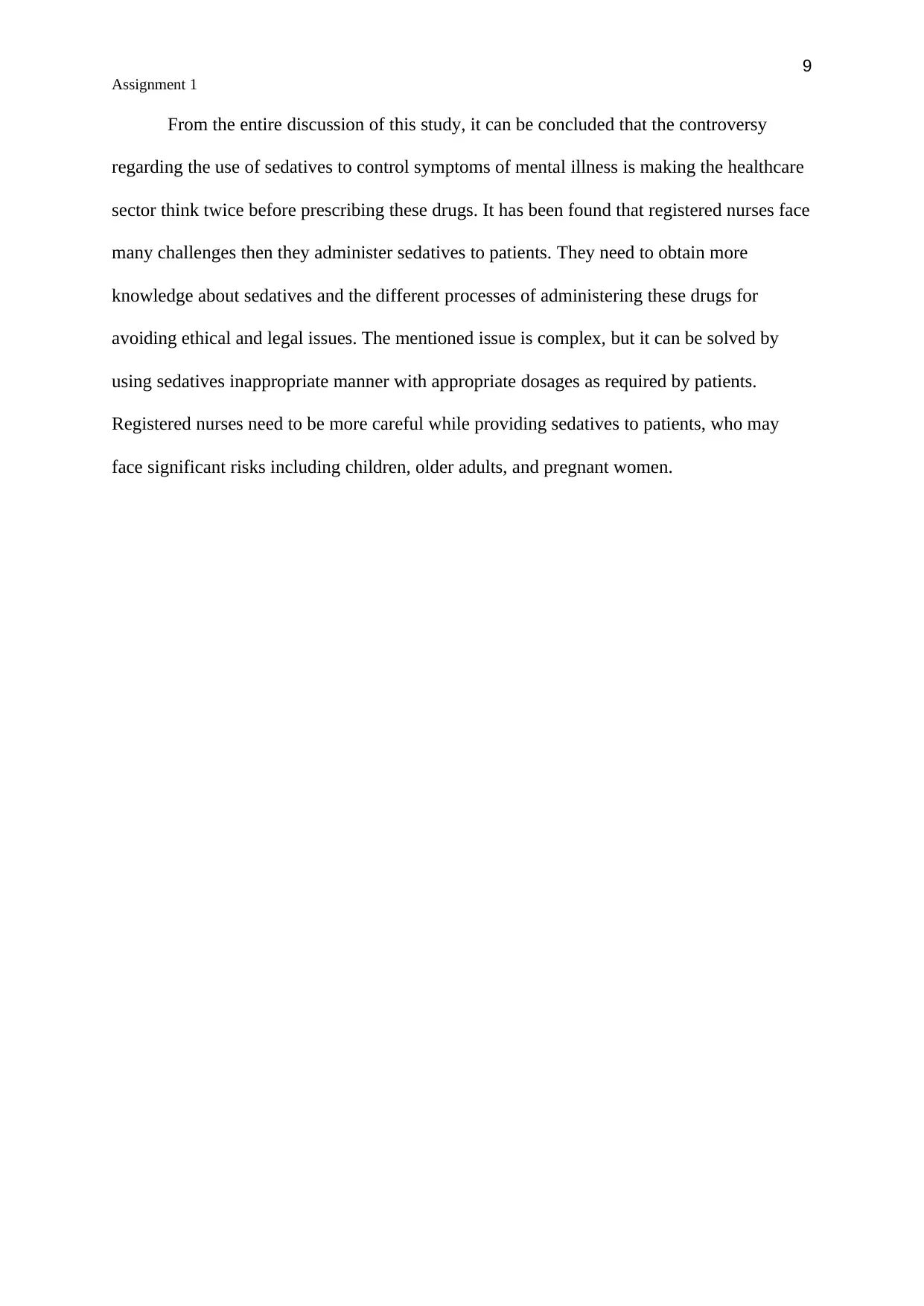
9
Assignment 1
From the entire discussion of this study, it can be concluded that the controversy
regarding the use of sedatives to control symptoms of mental illness is making the healthcare
sector think twice before prescribing these drugs. It has been found that registered nurses face
many challenges then they administer sedatives to patients. They need to obtain more
knowledge about sedatives and the different processes of administering these drugs for
avoiding ethical and legal issues. The mentioned issue is complex, but it can be solved by
using sedatives inappropriate manner with appropriate dosages as required by patients.
Registered nurses need to be more careful while providing sedatives to patients, who may
face significant risks including children, older adults, and pregnant women.
Assignment 1
From the entire discussion of this study, it can be concluded that the controversy
regarding the use of sedatives to control symptoms of mental illness is making the healthcare
sector think twice before prescribing these drugs. It has been found that registered nurses face
many challenges then they administer sedatives to patients. They need to obtain more
knowledge about sedatives and the different processes of administering these drugs for
avoiding ethical and legal issues. The mentioned issue is complex, but it can be solved by
using sedatives inappropriate manner with appropriate dosages as required by patients.
Registered nurses need to be more careful while providing sedatives to patients, who may
face significant risks including children, older adults, and pregnant women.
⊘ This is a preview!⊘
Do you want full access?
Subscribe today to unlock all pages.

Trusted by 1+ million students worldwide
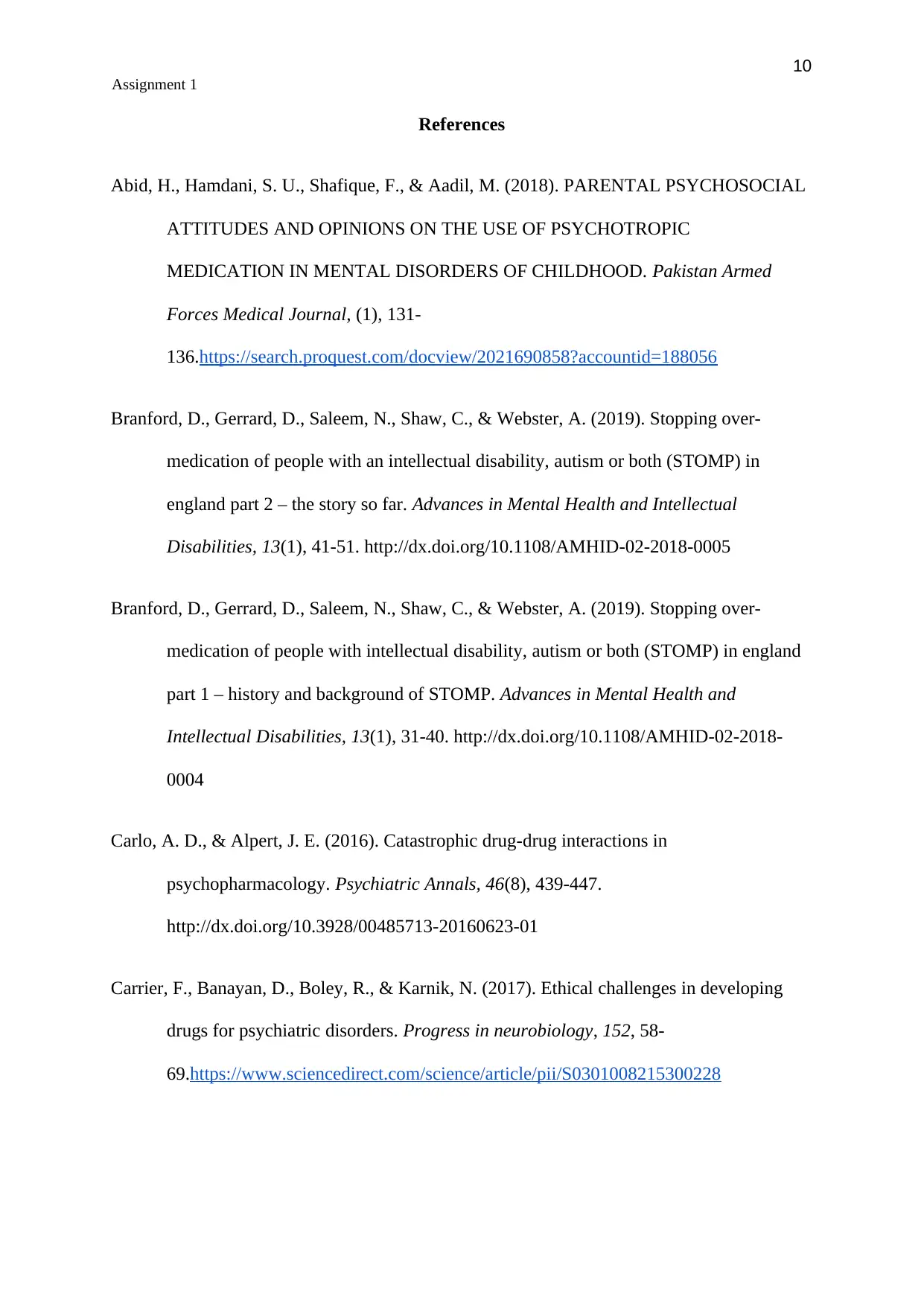
10
Assignment 1
References
Abid, H., Hamdani, S. U., Shafique, F., & Aadil, M. (2018). PARENTAL PSYCHOSOCIAL
ATTITUDES AND OPINIONS ON THE USE OF PSYCHOTROPIC
MEDICATION IN MENTAL DISORDERS OF CHILDHOOD. Pakistan Armed
Forces Medical Journal, (1), 131-
136.https://search.proquest.com/docview/2021690858?accountid=188056
Branford, D., Gerrard, D., Saleem, N., Shaw, C., & Webster, A. (2019). Stopping over-
medication of people with an intellectual disability, autism or both (STOMP) in
england part 2 – the story so far. Advances in Mental Health and Intellectual
Disabilities, 13(1), 41-51. http://dx.doi.org/10.1108/AMHID-02-2018-0005
Branford, D., Gerrard, D., Saleem, N., Shaw, C., & Webster, A. (2019). Stopping over-
medication of people with intellectual disability, autism or both (STOMP) in england
part 1 – history and background of STOMP. Advances in Mental Health and
Intellectual Disabilities, 13(1), 31-40. http://dx.doi.org/10.1108/AMHID-02-2018-
0004
Carlo, A. D., & Alpert, J. E. (2016). Catastrophic drug-drug interactions in
psychopharmacology. Psychiatric Annals, 46(8), 439-447.
http://dx.doi.org/10.3928/00485713-20160623-01
Carrier, F., Banayan, D., Boley, R., & Karnik, N. (2017). Ethical challenges in developing
drugs for psychiatric disorders. Progress in neurobiology, 152, 58-
69.https://www.sciencedirect.com/science/article/pii/S0301008215300228
Assignment 1
References
Abid, H., Hamdani, S. U., Shafique, F., & Aadil, M. (2018). PARENTAL PSYCHOSOCIAL
ATTITUDES AND OPINIONS ON THE USE OF PSYCHOTROPIC
MEDICATION IN MENTAL DISORDERS OF CHILDHOOD. Pakistan Armed
Forces Medical Journal, (1), 131-
136.https://search.proquest.com/docview/2021690858?accountid=188056
Branford, D., Gerrard, D., Saleem, N., Shaw, C., & Webster, A. (2019). Stopping over-
medication of people with an intellectual disability, autism or both (STOMP) in
england part 2 – the story so far. Advances in Mental Health and Intellectual
Disabilities, 13(1), 41-51. http://dx.doi.org/10.1108/AMHID-02-2018-0005
Branford, D., Gerrard, D., Saleem, N., Shaw, C., & Webster, A. (2019). Stopping over-
medication of people with intellectual disability, autism or both (STOMP) in england
part 1 – history and background of STOMP. Advances in Mental Health and
Intellectual Disabilities, 13(1), 31-40. http://dx.doi.org/10.1108/AMHID-02-2018-
0004
Carlo, A. D., & Alpert, J. E. (2016). Catastrophic drug-drug interactions in
psychopharmacology. Psychiatric Annals, 46(8), 439-447.
http://dx.doi.org/10.3928/00485713-20160623-01
Carrier, F., Banayan, D., Boley, R., & Karnik, N. (2017). Ethical challenges in developing
drugs for psychiatric disorders. Progress in neurobiology, 152, 58-
69.https://www.sciencedirect.com/science/article/pii/S0301008215300228
Paraphrase This Document
Need a fresh take? Get an instant paraphrase of this document with our AI Paraphraser
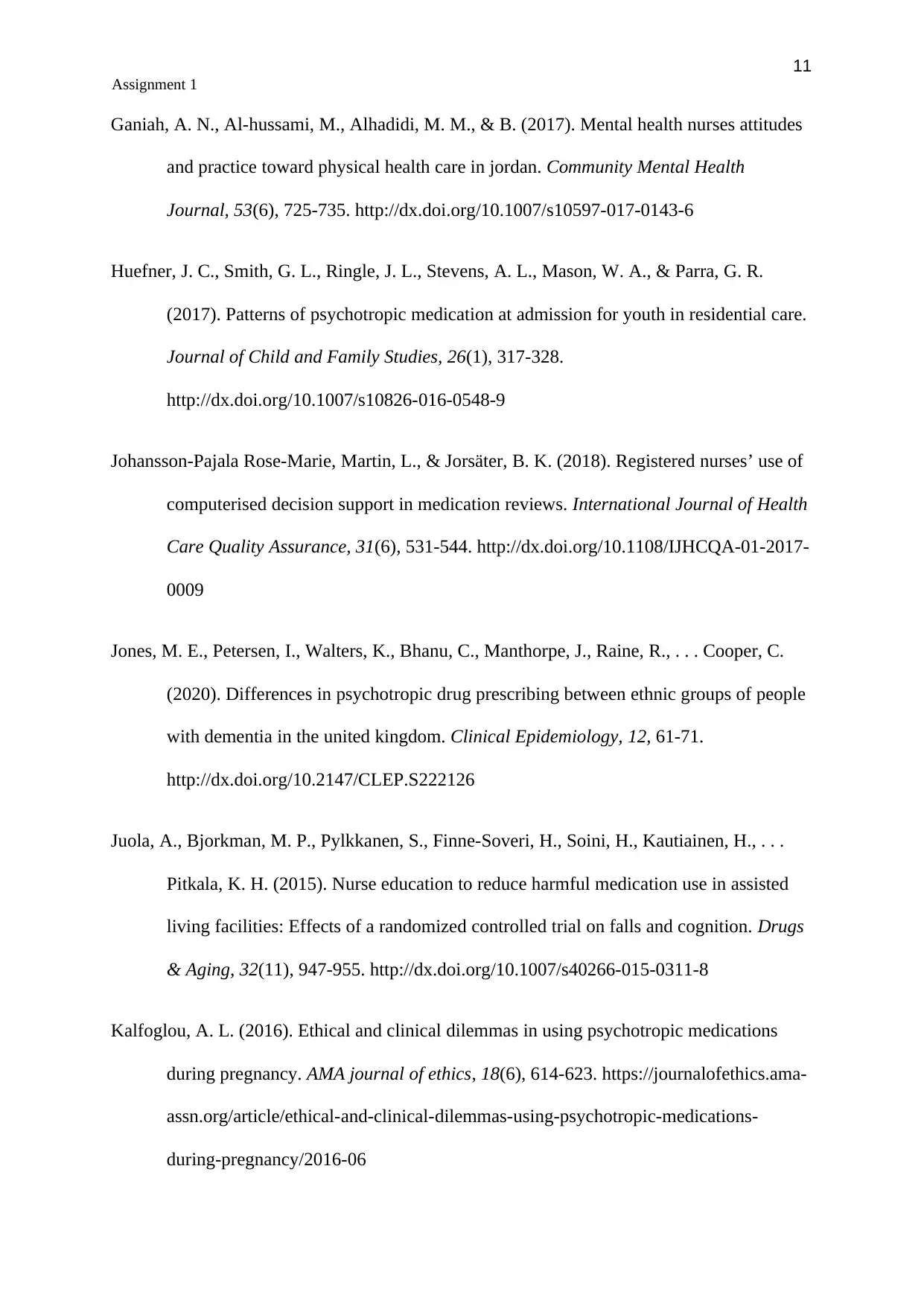
11
Assignment 1
Ganiah, A. N., Al-hussami, M., Alhadidi, M. M., & B. (2017). Mental health nurses attitudes
and practice toward physical health care in jordan. Community Mental Health
Journal, 53(6), 725-735. http://dx.doi.org/10.1007/s10597-017-0143-6
Huefner, J. C., Smith, G. L., Ringle, J. L., Stevens, A. L., Mason, W. A., & Parra, G. R.
(2017). Patterns of psychotropic medication at admission for youth in residential care.
Journal of Child and Family Studies, 26(1), 317-328.
http://dx.doi.org/10.1007/s10826-016-0548-9
Johansson-Pajala Rose-Marie, Martin, L., & Jorsäter, B. K. (2018). Registered nurses’ use of
computerised decision support in medication reviews. International Journal of Health
Care Quality Assurance, 31(6), 531-544. http://dx.doi.org/10.1108/IJHCQA-01-2017-
0009
Jones, M. E., Petersen, I., Walters, K., Bhanu, C., Manthorpe, J., Raine, R., . . . Cooper, C.
(2020). Differences in psychotropic drug prescribing between ethnic groups of people
with dementia in the united kingdom. Clinical Epidemiology, 12, 61-71.
http://dx.doi.org/10.2147/CLEP.S222126
Juola, A., Bjorkman, M. P., Pylkkanen, S., Finne-Soveri, H., Soini, H., Kautiainen, H., . . .
Pitkala, K. H. (2015). Nurse education to reduce harmful medication use in assisted
living facilities: Effects of a randomized controlled trial on falls and cognition. Drugs
& Aging, 32(11), 947-955. http://dx.doi.org/10.1007/s40266-015-0311-8
Kalfoglou, A. L. (2016). Ethical and clinical dilemmas in using psychotropic medications
during pregnancy. AMA journal of ethics, 18(6), 614-623. https://journalofethics.ama-
assn.org/article/ethical-and-clinical-dilemmas-using-psychotropic-medications-
during-pregnancy/2016-06
Assignment 1
Ganiah, A. N., Al-hussami, M., Alhadidi, M. M., & B. (2017). Mental health nurses attitudes
and practice toward physical health care in jordan. Community Mental Health
Journal, 53(6), 725-735. http://dx.doi.org/10.1007/s10597-017-0143-6
Huefner, J. C., Smith, G. L., Ringle, J. L., Stevens, A. L., Mason, W. A., & Parra, G. R.
(2017). Patterns of psychotropic medication at admission for youth in residential care.
Journal of Child and Family Studies, 26(1), 317-328.
http://dx.doi.org/10.1007/s10826-016-0548-9
Johansson-Pajala Rose-Marie, Martin, L., & Jorsäter, B. K. (2018). Registered nurses’ use of
computerised decision support in medication reviews. International Journal of Health
Care Quality Assurance, 31(6), 531-544. http://dx.doi.org/10.1108/IJHCQA-01-2017-
0009
Jones, M. E., Petersen, I., Walters, K., Bhanu, C., Manthorpe, J., Raine, R., . . . Cooper, C.
(2020). Differences in psychotropic drug prescribing between ethnic groups of people
with dementia in the united kingdom. Clinical Epidemiology, 12, 61-71.
http://dx.doi.org/10.2147/CLEP.S222126
Juola, A., Bjorkman, M. P., Pylkkanen, S., Finne-Soveri, H., Soini, H., Kautiainen, H., . . .
Pitkala, K. H. (2015). Nurse education to reduce harmful medication use in assisted
living facilities: Effects of a randomized controlled trial on falls and cognition. Drugs
& Aging, 32(11), 947-955. http://dx.doi.org/10.1007/s40266-015-0311-8
Kalfoglou, A. L. (2016). Ethical and clinical dilemmas in using psychotropic medications
during pregnancy. AMA journal of ethics, 18(6), 614-623. https://journalofethics.ama-
assn.org/article/ethical-and-clinical-dilemmas-using-psychotropic-medications-
during-pregnancy/2016-06
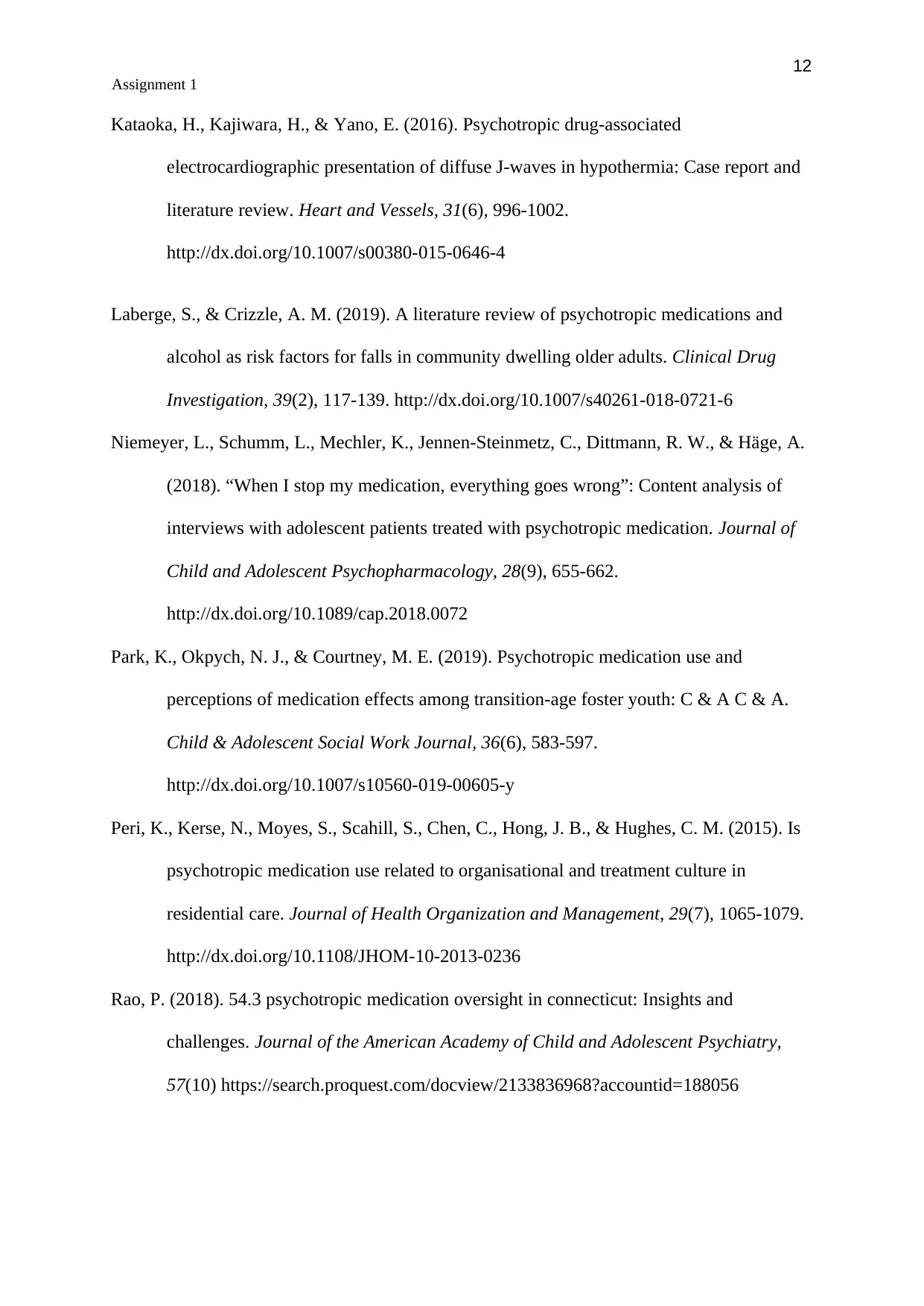
12
Assignment 1
Kataoka, H., Kajiwara, H., & Yano, E. (2016). Psychotropic drug-associated
electrocardiographic presentation of diffuse J-waves in hypothermia: Case report and
literature review. Heart and Vessels, 31(6), 996-1002.
http://dx.doi.org/10.1007/s00380-015-0646-4
Laberge, S., & Crizzle, A. M. (2019). A literature review of psychotropic medications and
alcohol as risk factors for falls in community dwelling older adults. Clinical Drug
Investigation, 39(2), 117-139. http://dx.doi.org/10.1007/s40261-018-0721-6
Niemeyer, L., Schumm, L., Mechler, K., Jennen-Steinmetz, C., Dittmann, R. W., & Häge, A.
(2018). “When I stop my medication, everything goes wrong”: Content analysis of
interviews with adolescent patients treated with psychotropic medication. Journal of
Child and Adolescent Psychopharmacology, 28(9), 655-662.
http://dx.doi.org/10.1089/cap.2018.0072
Park, K., Okpych, N. J., & Courtney, M. E. (2019). Psychotropic medication use and
perceptions of medication effects among transition-age foster youth: C & A C & A.
Child & Adolescent Social Work Journal, 36(6), 583-597.
http://dx.doi.org/10.1007/s10560-019-00605-y
Peri, K., Kerse, N., Moyes, S., Scahill, S., Chen, C., Hong, J. B., & Hughes, C. M. (2015). Is
psychotropic medication use related to organisational and treatment culture in
residential care. Journal of Health Organization and Management, 29(7), 1065-1079.
http://dx.doi.org/10.1108/JHOM-10-2013-0236
Rao, P. (2018). 54.3 psychotropic medication oversight in connecticut: Insights and
challenges. Journal of the American Academy of Child and Adolescent Psychiatry,
57(10) https://search.proquest.com/docview/2133836968?accountid=188056
Assignment 1
Kataoka, H., Kajiwara, H., & Yano, E. (2016). Psychotropic drug-associated
electrocardiographic presentation of diffuse J-waves in hypothermia: Case report and
literature review. Heart and Vessels, 31(6), 996-1002.
http://dx.doi.org/10.1007/s00380-015-0646-4
Laberge, S., & Crizzle, A. M. (2019). A literature review of psychotropic medications and
alcohol as risk factors for falls in community dwelling older adults. Clinical Drug
Investigation, 39(2), 117-139. http://dx.doi.org/10.1007/s40261-018-0721-6
Niemeyer, L., Schumm, L., Mechler, K., Jennen-Steinmetz, C., Dittmann, R. W., & Häge, A.
(2018). “When I stop my medication, everything goes wrong”: Content analysis of
interviews with adolescent patients treated with psychotropic medication. Journal of
Child and Adolescent Psychopharmacology, 28(9), 655-662.
http://dx.doi.org/10.1089/cap.2018.0072
Park, K., Okpych, N. J., & Courtney, M. E. (2019). Psychotropic medication use and
perceptions of medication effects among transition-age foster youth: C & A C & A.
Child & Adolescent Social Work Journal, 36(6), 583-597.
http://dx.doi.org/10.1007/s10560-019-00605-y
Peri, K., Kerse, N., Moyes, S., Scahill, S., Chen, C., Hong, J. B., & Hughes, C. M. (2015). Is
psychotropic medication use related to organisational and treatment culture in
residential care. Journal of Health Organization and Management, 29(7), 1065-1079.
http://dx.doi.org/10.1108/JHOM-10-2013-0236
Rao, P. (2018). 54.3 psychotropic medication oversight in connecticut: Insights and
challenges. Journal of the American Academy of Child and Adolescent Psychiatry,
57(10) https://search.proquest.com/docview/2133836968?accountid=188056
⊘ This is a preview!⊘
Do you want full access?
Subscribe today to unlock all pages.

Trusted by 1+ million students worldwide
1 out of 13
Related Documents
Your All-in-One AI-Powered Toolkit for Academic Success.
+13062052269
info@desklib.com
Available 24*7 on WhatsApp / Email
![[object Object]](/_next/static/media/star-bottom.7253800d.svg)
Unlock your academic potential
Copyright © 2020–2025 A2Z Services. All Rights Reserved. Developed and managed by ZUCOL.





